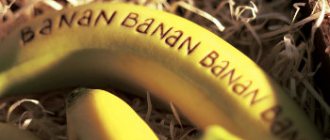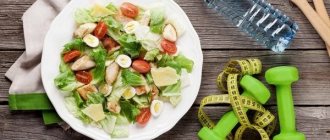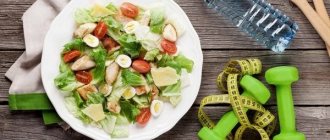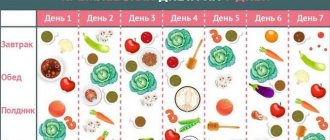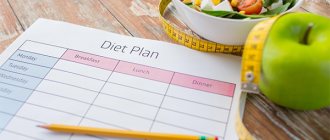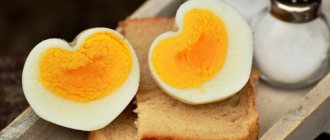Japanese diet, despite its name, has nothing to do with Japan. It is impossible to find the author of the diet; there are a dozen different versions floating around on the Internet. However, this menu has long proven its effectiveness: some people lost money on it up to 8 kg in one week.
The essence of the Japanese diet is to follow a low-calorie menu for 1-2 weeks. Products are selected in such a way as to dull the feeling of hunger: proteins in meat and fish satiate well, voluminous vegetable salads also quickly contribute to satiety.
Interestingly, some suggest eating with chopsticks, studying Japanese literature and listening to national music of Japan during strict weight loss. There is a certain meaning in this - a person eats with chopsticks slower than with a spoon. Accordingly, saturation occurs faster, so you definitely won’t want to go for more!
Features of the Japanese diet
- Ready-made menu , you don’t have to think about your diet.
- No salt. It is forbidden to add salt to dishes; you can use spices and non-calorie sauces (for example, soy sauce).
- No breakfast . Most days you'll have to stick to a black Americano or espresso for breakfast, sometimes with rye toast. This rule goes against what nutritionists recommend, but it allows you to achieve quick results.
- 3 meals are optimal instead of the 5-6 recommended by nutritionists.
- You can prepare vegetable salads from permitted products and eat them in any quantity (without salt).
- Every morning you will have to drink Americano or espresso , but if you are intolerant to this product, you can replace it with tea: black or green.
- A hot drink is a must every morning on the “Japanese” - it will give you strength and dull the feeling of hunger.
Negative sides
A carbohydrate-free diet rarely goes without consequences; metabolism with the allowed 800 calories slows down significantly; in the presence of chronic diseases, they can worsen.
- The body stops working fully, this is due to a lack of macro and microelements; to achieve the goal, you need to show maximum desire.
- Coffee, which will replace breakfast, can negatively affect the functioning of the cardiovascular system, and a meager menu often leads to psychological pressure.
Concentration deteriorates significantly, because a person constantly experiences a feeling of hunger, fatigue at the workplace leads to decreased performance and problems with superiors.
Products
| Allowed | Prohibited |
|
|
List of staple foods for the Japanese diet for 14 days
- Fresh chicken eggs - 2 dozen;
- Chicken fillet - 1 kg;
- Fresh carrots - 2-3 kg;
- Tomato juice - 1 l.;
- High-quality coffee beans or ground - 1 pack;
- White cabbage - 2 medium sized forks;
- Fruits (except bananas and grapes) - 1 kg. total;
- Selected lemons - 2 pcs.;
- Sea fish fillet - 2 kg;
- Zucchini, eggplant - 1 kg. total;
- Kefir - 1 l. (buy fresh, don’t store for future use!);
- Lean beef, pulp - 1 kg;
- Extra virgin olive oil - 500 ml;
- Green tea of your favorite variety (without additives or flavorings) - 1 pack.
Advantages and disadvantages
| Advantages | Flaws |
| Fast weight loss. In just one week on the “Japanese” diet, those losing weight notice a loss of 5-7 kg. Moreover, the products are selected in such a way that the weight will not return (if you follow the principles of a balanced diet). | The diet is low in calories, so weakness and dizziness are possible. Once these symptoms occur, if they do not stop, it is better to end the diet. |
| Hunger will torment you less, because the menu contains a lot of protein, nutritious foods - meat and fish. | The diet is not balanced enough , if you follow it, take a multivitamin. |
| Available products. The Japanese diet menu includes simple vegetables and meat, which you can find in any store or even grow in your country house. | Almost complete absence of carbohydrates, as a result – low energy levels, irritability. |
Results, timing and frequency
The classic Japanese diet lasts 14 days, but a certain set of products has been created for the diet for 7 and 13 days. They adhere to one of the diets no more than once every one or two years, since diets are considered strict due to the small amount of calories and vitamins.
By following a diet
for 7 days you can lose 3-5 kg . In 13 and 14 days you can get rid of 2-7 centimeters on the waist and hips and 4-8 kg of excess weight, which depends on the person’s constitution.
Some people lose weight easily, while others gain them easily. Therefore, it is imprudent to throw a holiday for your stomach when leaving the diet. The body has an amazing memory, so it will begin to accumulate energy and fats with double strength. It is better to start losing weight and cleansing the body during the season of young vegetables and ripe fruits and berries, so that the body feels comfortable, and lovers of the Japanese diet are not tormented by thoughts of buns or ice cream, smoked and salted fish or raw smoked sausage. Only a comfortable diet will guarantee that you will not gain weight for quite a long time.
Diet rules
- Prepare to start your diet the day before. Avoid sweets and fatty foods, bake a chicken breast in the oven in the evening, prepare a vegetable salad or stew vegetables. This will make the transition to a diet easier.
- Drink water 1.5 - 2 liters per day at least. Water will save you from the feeling of hunger that is inevitable on the Japanese diet. Moreover, giving up water, although it will help you lose weight faster, will result in dehydration and poor health.
- The strict requirement of the “Japanese”: there are only certain products, in designated volumes and at the right time. You cannot swap days or add any new dishes.
Contraindications
There are also certain contraindications for this type of nutrition:
- Problems with the digestive system.
- Periods of lactation and pregnancy.
- Problems with cardiac activity.
- Kidney and liver diseases.
If immediately after starting the diet you begin to feel dizzy or feel muscle soreness, then you should stop continuing the diet.
It is better to consult a specialist before and after the diet, especially if you have any problems with the body.
Kinds
- Seven-day Japanese diet: Pros of the diet: short, easier to tolerate.
- Cons: you won’t be able to significantly reduce the amount of fat in your body in a week; only excess water will go away.
Doctors' opinion on a salt-free diet
The Japanese diet, designed for 13 days, gives good results, but requires care and concern for health. Doctors believe that it is worth sticking to such a diet once every one and a half to two years, so that the body has time to recover and function well. Too much salt deprivation can cause problems in some organs.
The diet provides the body with a small amount of vitamins, but in order to support the body and not deteriorate the quality of skin, nails and hair, experts recommend taking a multivitamin complex during this diet.
A diet so low in carbohydrates and low in calories can cause stress on the body. Therefore, it should be carried out only with the permission of your attending physician, under his guidance. There are a number of diseases for which this diet is strictly prohibited - this includes, for example, heart disease or eating disorders. Mothers cannot hold it back either, as long as the child’s nutrition is at least slightly connected with their body.
Return to content
Menu
For 7 days
Detailed menu for 7 days in the table:
| Day | Menu |
| Day 1 | Breakfast: Americano – coffee without milk, don’t add sugar either Dinner: boil a couple of hard-boiled eggs, chop Chinese cabbage salad, drink 1 glass of tomato juice. Dinner: fish – boiled or steamed (250 g) |
| Day 2 | Breakfast: drink an Americano, eat rye bread toast Dinner: boil 250 g fish, chop cabbage salad Dinner: boil 100 g of beef, drink a glass of one percent kefir |
| Day 3 | Breakfast: drink an Americano, eat a rye bread cracker Dinner: eat the zucchini, which you must fry in a drop of oil Dinner: boil a couple of eggs, boil beef (200 g), prepare a salad of Chinese (Beijing) cabbage |
| Day 4 | Breakfast: drink an Americano or espresso, without sugar Dinner: eat a piece of cheese (15 g), hard boil 1 egg, boil 1 carrot (150-200 g) Dinner: eat 2 small apples, sprinkle with cinnamon |
| Day 5 | Breakfast: carrots - boil and sprinkle with the juice of one lemon. Dinner: boil or steam fish (200 g), drink 1 glass of tomato juice (without sugar and salt or homemade) Dinner: eat 2 medium apples |
| Day 6 | Breakfast: drink an Americano Dinner: boil chicken (500 g), prepare cabbage-carrot salad with olive oil Dinner: chop cabbage salad, boil a couple of eggs |
| Day 7 | Breakfast: drink green tea Dinner: boil beef (200 g), eat fruit (choice: apple, pear, orange) Dinner: select any dinner menu from previous days, except the third day |
For 14 days
Detailed menu for 14 days in the table:
| Day | Menu |
| Day 1 | Breakfast: drink an Americano Dinner: boil a couple of eggs, chop Chinese cabbage salad (without salt, with a tablespoon of oil), drink 1 glass of tomato juice. It is better to make the juice yourself, or find tomato juice in the store without added salt and sugar. Dinner: boil or steam fish (250 g) |
| Day 2 | Breakfast: eat rye bread toast (if you don’t have a toaster, dry the bread in the oven), drink an Americano Dinner: boil fish (200 g), chop white cabbage salad Dinner: boil beef (100 g) and drink a glass of kefir |
| Day 3 | Breakfast: eat rye bread, drink Americano Dinner: eat the zucchini, which you must fry in a drop of oil Dinner: boil beef, do not add salt (200 g), hard boil a couple of eggs, chop fresh cabbage salad |
| Day 4 | Breakfast: Grate medium-sized carrots on a coarse grater, sprinkle with the juice of one lemon. Dinner: bake fish (200 g), drink 1 glass of tomato juice (without salt or sugar, homemade is better) Dinner: eat 200 g of any fruit (for example, one large apple) |
| Day 5 | Breakfast: eat a small fresh carrot with the juice of one lemon Dinner: boil fish (200 g), drink tomato juice – 1 glass (no salt or sugar in the composition, homemade is better) Dinner: eat 200 g of any fruit |
| Day 6 | Breakfast: drink an Americano Dinner: cook chicken without salt (500 g), cut carrot and cabbage salad Dinner: grate fresh medium-sized carrots, boil a couple of eggs |
| Day 7 | Breakfast: drink green tea Dinner: boil beef, without salt (200 g) Dinner: Choose the diet for any dinner from the past seven days |
| Day 8 | Breakfast: drink an Americano Dinner: boil chicken without salt (500 g), chop cabbage and carrot salad Dinner: make a salad of fresh carrots, boil a couple of hard-boiled eggs |
| Day 9 | Breakfast: grate fresh carrots on a coarse grater, pour in the juice of one lemon Dinner: bake fish with spices (200 g), drink 1 glass of tomato juice (without salt and sugar, homemade is better) Dinner: eat 200 g of any fruit |
| Day 10 | Breakfast: drink an Americano Dinner: eat 50 g of hard cheese, chop fresh carrot salad, boil 1 egg Dinner: eat 200 g of any fruit |
| Day 11 | Breakfast: eat rye bread, drink an Americano Dinner: fry a medium-sized zucchini in a small amount of oil, you can add spices Dinner: boil beef (200 g), boil a couple of eggs, chop cabbage salad |
| Day 12 | Breakfast: eat rye bread toast, drink espresso diluted with water Dinner: fry fish (200 g), chop white cabbage salad Dinner: boil beef (100 g), drink a glass of kefir 1% fat |
| Day 13 | Breakfast: drink an Americano Dinner: hard boil a couple of eggs, boil the cabbage, drink tomato juice - 1 glass (look for it without sugar and salt, homemade is better) Dinner: boil fish without salt (200 g) |
| Day 14 | Breakfast: drink an Americano Dinner: fry fish (200 g), chop fresh cabbage salad Dinner: boil beef (200 g), drink 1 glass of kefir |
Warnings
As can be noted, the Japanese diet contains all the essential nutrients, but with serious restrictions on composition and quantity. Therefore, this diet cannot be considered balanced and cannot be followed for more than 14 days so as not to harm your health.
Be careful because in the first days of the diet, your body may react differently to reducing the amount of carbohydrates in your diet: you may experience body aches, weakness, dizziness and headache. If you have such symptoms, do not torture yourself and your body, quit the diet and be sure to get examined by a doctor!
The main way to achieve the desired result on the Japanese diet within 14 days is to strictly follow its plan.
It is forbidden to change days and consume non-recommended products at will. The only exception is morning coffee - it can be replaced with a cup of green tea without sugar. You should avoid salt for the entire duration of the diet, but if this prohibition causes discomfort for your taste buds, then add minimal salt to your food.
Since the Japanese diet for 14 days is quite strict, before starting it you should prepare your body and prepare yourself psychologically. By giving up sweets and fast food, reduce your usual portion size. At the end of the diet, you will receive your reward for your work - in 14 days the Japanese diet allows you to get rid of 5 extra pounds.
Recipes
Despite the fact that the Japanese diet involves a limited list of products, even from them you can prepare the right tasty dishes for variety in your diet.
Vegetable dishes
Fresh coleslaw
Ingredients:
- 200-300 g cabbage;
- olive oil;
- lemon juice;
- greenery.
Preparation:
- chop the cabbage finely;
- put it in a large plate, remember with your hands - this will give the cabbage juice and the salad will become tastier;
- for 300-400 grams of fresh cabbage, you can add 1 tablespoon of oil: high-quality sunflower or olive;
- You cannot add salt, but you can season the salad with black or red pepper and lemon juice;
- this salad will become tastier if you add fresh herbs to it: dill, parsley, cilantro (or use a dried analogue of these herbs).
Cabbage and carrot salad
Ingredients:
- 200-300 g cabbage;
- olive oil;
- lemon juice;
- greenery.
Preparation:
- cabbage must be chopped;
- knead with your hands;
- add fresh carrots: grate them on a coarse grater;
- add to cabbage;
- Season the salad with a mixture of peppers, oil and lemon juice.
Fresh carrot salad
Ingredients:
- 2-3 medium carrots;
- lemon juice;
- 1 tablespoon olive or sunflower oil;
- greenery.
Preparation:
- Grate 2-3 medium carrots on a coarse grater;
- add lemon juice, 1 tablespoon olive or sunflower oil;
- Fresh herbs, especially basil and cilantro, also go well with fresh carrots;
- You can add mint to make the salad taste fresher.
Boiled carrot salad “Moroccan style”
Ingredients:
- 1 carrot;
- 1 tablespoon vegetable oil;
- lemon juice;
- Khmeli-Suneli spices and fresh cilantro.
Preparation:
- boil the carrots;
- cut it into quarters or large cubes;
- prepare the dressing: 1 tablespoon of vegetable oil, lemon juice, Khmeli-Suneli spices and fresh cilantro;
- mix everything.
Braised cabbage
Ingredients:
- 300-400 grams of white cabbage;
- 1 tablespoon of vegetable oil.
Preparation:
- classic recipe for stewed cabbage - it will serve as a substitute for boiled cabbage;
- Chop 300-400 grams of fresh white cabbage and remember that the cabbage gives juice;
- Heat a deep frying pan over medium heat;
- pour 1 tablespoon of vegetable oil there;
- Place the cabbage in a hot frying pan, cover with a lid, but do not forget to stir;
- when the cabbage is slightly fried, add 1-2 cups of hot water to the pan;
- after the water boils, reduce the heat to low;
- simmer covered for another 10-20 minutes until the cabbage is soft.
Japanese cabbage salad
Ingredients:
- Chinese cabbage;
- 1 tbsp. l. vegetable or olive oil;
- soy sauce;
- 1 tsp sesame seeds;
- dried ginger.
Preparation:
- to truly breathe in the spirit of Japan, try making this salad, suitable for those days when Chinese (sometimes also called Chinese) cabbage is allowed;
- cut the cabbage into thin strips, place in a deep plate;
- prepare the dressing: 1 tablespoon vegetable or olive oil, soy sauce, 1 teaspoon sesame seeds, dried ginger (or finely chopped, about 1/3-1/2 teaspoon);
- Whisk the dressing until you get a smooth sauce;
- add the sauce to the salad, mix well;
- This salad becomes even tastier the next day, when the cabbage absorbs the aroma of the dressing.
Fruit salad
Ingredients:
- fresh orange or lemon juice;
- apples;
- pears;
- berries.
Preparation:
- on days when fruits are allowed, you can treat yourself to this salad;
- here the dressing will be the juice of fresh orange and/or lemon;
- Apples or pears with fresh berries are good for this salad;
- cut apples or pears into cubes, add berries and pour fruit juice over it all;
- it must be prepared at home; store-bought versions often contain sugar;
- the main thing is to observe the grams of the dish, no more than 200 g of fruit per meal.
Fish dishes
Baked fish
Ingredients:
- lean fish fillet;
- lemon juice;
- garlic;
- ground black pepper.
Preparation:
- for this recipe you will need lean fish fillet;
- place it in foil;
- sprinkle with lemon juice;
- sprinkle with dry garlic and black pepper;
- You can put fresh rosemary on top of the fish, it will make the dish more interesting;
- after you have added all the spices, cover the fish with foil and seal (this way the fish will remain juicy, because the juice will be inside);
- Bake in the oven preheated to 200 C for about 20-30 minutes until the fish is soft.
Fried fish in soy sauce
Ingredients:
- fish fillet;
- sunflower oil;
- 1 spoon of sesame seeds.
Preparation:
- cut the fish into large pieces;
- pour soy sauce so that it slightly covers the fish;
- leave for 20-30 minutes;
- fry in a hot frying pan with a spoon of sunflower oil until the fish becomes crispy and soft;
- When the fish pieces are cooked, place them on a plate and add 1 spoon of sesame seeds.
Japanese salt-free diet for 14 days: list of allowed foods
Dishes consisting of fish or animal meat with a side dish of vegetables are quite popular and many people eat them every day. It is psychologically difficult for people to give up spices, especially salt, and various sweets in the form of baked goods, confectionery and sweets.
Forcing yourself to forget about sweets and treats for a week or two is a problem. It would be useful, before starting a diet, many people should cleanse their body and temporarily switch to proper nutrition without salt.
Read the ARTICLE about fasting days
Allowed products for weight loss in the “Japanese” diet:
- Rusks from dark bread;
- Kefir or yogurt, preferably homemade natural;
- It is advisable to consume tomato juice, homemade or purchased with pulp. Regular packaged juice contains salt, which is prohibited;
- Hard low-fat cheese;
- Natural coffe;
- Sea fish, beef, chicken, boiled or steamed;
- Chicken or quail eggs, raw or boiled (hard-boiled);
- Zucchini, eggplant, parsnip root fried in oil;
- Unsweetened fruits, most often apples, pears, citrus fruits;
- Green tea without additives or flavorings;
- Mineral or purified water without gas;
- Lemon, the juice of which can be added to dishes to improve the taste;
- Vegetable oil – olive or unrefined sunflower;
- Fruits: cherries, apples, kiwi, citrus fruits, pear, plum;
- Fresh vegetables: cabbage and carrots, raw and boiled. You can eat it whole, in pieces, chopped or grated.
Products and spices that are not included in this list are considered prohibited. Fruits such as grapes and bananas are also prohibited.
Drinks prohibited are lemonade, juice, soda, and alcohol of any strength. A categorical taboo on various sauces, spices, marinades.
Japanese diet menu
Exit rules
- Get ready for a gradual exit from the diet: it is believed that the exit from this diet should exceed the duration of the diet itself.
- Eat small portions: do not stretch your stomach - due to modest nutrition during the diet, it has shrunk, this will prevent you from gaining weight back.
- Continue to follow the key rules of the Japanese diet: eat plenty of vegetables, lean meat. You can introduce cereals like rice or buckwheat into your diet in small portions.
- Do not start your diet with desserts and baked goods - you risk losing weight, but the kilograms will only add. Add your favorite foods gradually, in small portions.
Drink at least 1.5-2 liters of water, this rule should be followed throughout your life!
Japanese diet for 14 days: main principles of dietary nutrition
The Japanese diet was developed about 16 years ago, during which time many people who wanted to lose weight appreciated its effectiveness. The Japanese diet implies a salt-free diet with a significant reduction in carbohydrates.
A characteristic feature of the diet is three meals a day and plenty of liquid. This diet is suitable for people aged 18 to 40 years and is not gender specific, that is, the diet is suitable for both men and women.
The basic rules for using the Japanese diet are:
- It is necessary to monitor the consumption of large amounts of clean water;
- Fish can be eaten not only boiled;
- There are no restrictions on the use of cereals, in most cases rice, legumes;
- Eating cabbage and other vegetables is allowed;
- It is strictly forbidden to consume simple carbohydrates for 14 days;
- When preparing dishes, you must use only recommended products;
- It is acceptable to drink morning coffee without sugar;
- It is forbidden to switch days of the diet: on the fifth day you must eat only those dishes that are prescribed for that day;
- When preparing dishes, the priority remains lean beef, although it is acceptable to use skinless chicken.
“Japanese” is based on reducing daily calories and giving up carbohydrates, especially fast ones. Dietary nutrition involves avoiding salt, fatty, and smoked foods. Products such as alcohol, juices, soda and any fast food are also contraindicated during the diet.
Strict adherence to these tips leads to an acceleration of metabolism, as a result of which excess fat deposits are burned and converted into energy. The Japanese diet belongs to the class of protein diets. The basis of nutrition is chicken eggs, rabbit and chicken meat, fish and some dairy products.
Of carbohydrates, only some vegetables are allowed to be consumed in small quantities. A prerequisite is the normalization of water balance; in addition to the fact that those losing weight need to drink at least 2 liters of clean water, the menu must also include green tea, coffee or chicory.
Basic principles of proper nutrition:
- Individual choice of Japanese diet: for 7 and 14 days. If you have a small amount of excess weight, it is enough to stick to the diet for 7 days. If you are overweight, it is better to follow the Japanese diet for 14 days; reviews show that in the first case, weight loss is about 6 kilograms, in the second - up to 10 kilograms;
- Strict adherence to the diet: the proposed products cannot be replaced with alternative ones. You can only use tomato juice instead of tomatoes, white cabbage instead of spinach;
- Strict absence of sugar: all refined carbohydrates, sweet foods, baked goods and flour products, honey are strictly prohibited;
- A gradual entry and exit from the Japanese diet is required. Results are less noticeable in those who switch to this diet from another diet. And they are clearly visible if the preliminary nutrition was not dietary. If you have a full diet on the eve of the “Japanese” meal, you should arrange a fasting day (kefir or apple) or at least make a light dinner (some boiled brown rice with a salad of fresh vegetables). When leaving, you should introduce everyday foods gradually, about 1 per week;
- Mandatory lack of salt: the salt-free Japanese diet is aimed at removing excess fluid from the body, due to which up to 30% of excess weight is lost;
- Prohibition of exceeding deadlines. It is strictly forbidden to continue dietary nutrition for more than 14 days due to the danger to the body;
- A sufficient amount of fluid is necessary: during the day you should drink 2 liters of still water. Tea (you can drink green) and coffee are not included in this volume;
- Strict adherence to consistency: the Japanese diet, the menu of which is designed with the goal of gradual weight loss and long-term preservation of the result, does not tolerate changes in the proposed diet. You cannot rearrange the days and menus for breakfast, lunch, and dinner.
How many kilograms can you lose?
Depending on the amount of excess weight, you can lose from 5 to 8 kg in two weeks. Women with 20-30 kilograms of excess weight can lose at least 10 kilograms.
Despite the impressive results, it is not recommended to constantly adhere to this diet: it is low in calories and poor in nutrients, which means it can harm women’s health. Skin, nails, teeth will deteriorate, the reproductive system and gastrointestinal tract will suffer. The Japanese diet should not be repeated too often: once every six months is optimal.
Japanese diet – reviews and results with before and after photos
“My parents introduced me to this diet at one time after it was recommended to them by a friend from Japan. As a 16-year-old teenager, I didn’t understand why the menu would change so radically. But from the entire list of permitted products, my mother managed to prepare delicious dishes. At the same time, she lost up to 7 kg in a month. Now I sometimes go on a Japanese diet once a year, and I like the results.”
“I tried so many diets, none of them gave good, lasting results. I read reviews about the Japanese diet for 13 days and decided to try it too. I love fish, so I was very pleased with the menu. I gave up salt, sugar and confectionery. In 13 days I managed to lose 3 kg, and I began to feel much better. When combined with physical activity in the gym, it gives even greater results.”
“I don’t really like seafood and oriental cuisine in general, but for the sake of a good result I decided to be patient. I tried to create a varied menu - this was the most difficult thing. As a result, I lost 4 kg in two weeks and was very pleased. True, two months later I gained a couple of extra pounds again. I think I’ll try this diet again in six months. In general, it is easily tolerated. I gave up salt and sweets without difficulty.”
“I decided to lose weight on this Japanese diet. Started with 105 kg. Now it's day 8 of the diet. I combine it with physical activity. I completely eliminated simple carbohydrates, before training I try to eat something with complex carbohydrates and protein so that I have the strength to train. The sweets are in the trash, the salt is also removed. Now my weight is 100 kg, I can already see changes in the mirror. I will continue to continue, I think I will last 13 days.”
“It’s a difficult diet for me, but it’s very effective. The menu mainly consists of fish, lean meat and vegetables. The menu has been slightly reworked, dividing three meals into five. This is even more effective, metabolism accelerates better. I read reviews and results with photos of the Japanese diet, and everyone writes about how they lost almost 10 kg. I didn't get this result. In two months I got rid of 10 kg. It seems the results were even better than other diets.”
“At first, in the first two or three days it was very difficult. I simply adore sweets, and I can’t live without them. And I often treat myself to salty foods. And then I had to give up all these joys. The menu is also quite heavy: mostly fish and vegetables. In the first days I even felt dizzy, but this is more of a psychological moment. If you overcome this, then it will be easier. In fact, the Japanese diet is not that complicated if you think about the menu and allowed foods. I lost about 2 kg in two weeks.”
“I don’t recommend this diet for those who have gastritis. I broke down 10 days after starting the diet. I had to give up this diet because the disease worsened. In order not to spoil your stomach, you can probably adjust the menu a little. But in 10 days I still managed to lose 4 kilograms. I’ll try later, but first I’ll consult a doctor, maybe he can tell me how to improve my diet without harming my health.”
“Why are all the reviews about the Japanese diet for 14 days entirely positive? I have only negative experiences with this diet. I found out that I was allergic to fish products and felt terrible during the diet. It’s difficult without sweets, and even more so without salt. If anyone is allergic to permitted products, I do not recommend it. For all those who are mentally strong and are ready to give up many goodies, this scheme may be suitable.”
“I don’t understand how you can cope with this diet. No, of course there is no feeling of hunger. But constantly eating fish and vegetables is tough. The food is mostly protein, there are almost no carbohydrates. Where will the energy come from? I only withstood 7 days of such torture. I became lethargic and had almost no strength. Maybe the menu was compiled incorrectly, or maybe something else played a role. Of course there was a result. I lost 4 kg in just a week, but I probably don’t have enough willpower and I’m not mentally ready for such diets yet. I can only recommend everyone else to try it. Maybe you will succeed.”
“Before the diet, I was afraid that I would have to starve. But in fact, dishes made from permitted products turn out to be very satisfying. 200 grams of fish is enough for you to eat normally. I followed the diet not quite according to the rules. Sometimes I allowed myself to eat a small piece of marmalade or a piece of cheese. In general, I gave up sugar, flour products and salt. At the same time, I worked out in the gym. After two months, the scale shows minus 13 kg. A month later, the extra pounds have not returned. But to maintain such weight you have to watch your diet and do exercise.”
If you are a lover of seafood and protein foods, then we advise you to try this diet. Among the popular methods of losing weight, the Japanese diet is one of the most logical and correct nutritional systems.
26 45
Did you like the article? Share with friends:
Other diets for weight loss:
Buckwheat diet – reviews and weight loss results
Kremlin diet - table and menu for the week
Buckwheat diet - menu for weight loss for 14 days!
Diet ML
Maggi diet - menu and reviews
Angel Diet
Discussion:
- Fighter007 says:
The diet, of course, is quite correct in terms of the division into nutrients. Protein foods should prevail during weight loss. It is necessary to exclude sugar and simple carbohydrates in general from the diet. But there are also softer methods. I recently purchased the Fast Fat Burning manual. Everything about losing weight and cutting, and how to burn fat correctly is written there in black and white. I learned a lot of new things and now I successfully apply them in practice. - Katerina says:
Guys and girls, can someone send me at least a sample menu? At least see if it’s worth trying the Japanese scheme or if this is a rather difficult test.
- Jolie66 says:
I don’t like fish at all, so this option is not for me. It's unlikely that he'll come in. Of course it’s time to lose weight, but everything Japanese doesn’t suit me. What kind of FFB manual is this? They write about her everywhere now. Worth buying?
- Olezhka says:
Of course buy it! As a coach, I can say that the information provided there is decent. Everything is structured and logical. I carry it with me now to give to my clients at the gym to read. I have used some of the advice from there before. There is also something new that I discovered. I bought it on sale for only 290 rubles. I think this is a pittance of money for such knowledge.
- Timka30777 says:
I really can’t remember a single fat Japanese)) But it’s not clear what they usually eat there. The diet doesn't seem to be complicated, maybe it's worth a try. I saw before and after photos, and a friend of mine was on a Japanese diet. The result is impressive. Now I need to lose a few extra kilos, otherwise everyone is already called chubby. It’s not offensive, but you can’t let yourself go like that)
- Leonidovi4 says:
I bought the FFB manual and I’m not worried. I can create and schedule a diet for myself without the help of trainers. I don't understand why people don't want to spend a couple of hundred for such valuable information. Or is it easier to pay the coach a thousand rubles each training session? Everything is described normally in the manual.
- Nadenka says:
I work as a personal trainer. The students have already begun to leave me. I ask, and everyone says that they bought some kind of Fast Fat Burning, and now everyone knows. It turned out that the guys didn’t need it; they became independent. I freaked out and bought it for myself. I read and understand that soon people like me will really not be needed. People can get all the knowledge from such sources. And it costs absolutely nothing. Of course, it’s more profitable for them to do this than to pay me every time.
- Marinka666 says:
Since the drinking has started, I will also speak about FFB, even though there is an article about the Japanese diet. I recently bought this manual. I had enough knowledge to burn fat correctly. But until I read it. I still did some things wrong. I think that after a while my progress will be noticeably better, because there is really useful information there.
- Pavel41 says:
People, is it really possible to have coffee in the Japanese diet? I just can't wake up in the morning without it. And another question for those who have already gone through this diet: are there any side effects from it? Do you have problems with bad breath when you lose weight or maybe your general health is somehow affected?
- Valya says:
During the diet, they say the smell of your mouth really deteriorates. On the sites where I read reviews they talk about the smell of acetone. I don’t know if it’s true or not, I didn’t seem to have any problems with it, the guy didn’t complain)) I lost weight successfully on this diet.
- Ulyana says:
Somehow I can’t believe that with such a diet and menu you can lose up to 10 kg. It is doubtful that such a result will occur in just two weeks. I got rid of a maximum of 4 kg over such a period of time. Such sudden weight loss is not always good for the body.
- Yulenka says:
I liked that there was a ready-made menu, no need to rack my brains. The weight is gone and does not return if you develop the habit of not eating at night and gradually give up sweets. Good diet.
- Darina says:
Good article, thanks for the feedback. Now I will definitely try this diet. I'll write back as soon as I've had it for two weeks. And if I don’t hold out, I’ll also write back and tell you why I’m so weak-willed)))
- Warrior says:
Why are you racking your brains with all sorts of Japanese, European and other foreign diets? Buy the FFB manual while it costs only 290 rubles. The whole process is clearly explained there. What is possible, what is not. You will learn a lot. I bought it and don’t regret it. Now I’m gradually losing weight without problems and see results every day.
- Selena says:
Everyone is writing about FFB everywhere. I couldn't resist and bought it too. I’ve been doing this for a very long time, and the information there is really useful for beginners. This is a good guide and reference book for those who want to lose weight. It helped me refresh some points in my memory, and sometimes I re-read it.
- Olga says:
As a doctor, I say that the Japanese diet is not suitable for those who have problems with the gastrointestinal tract. For example, even a tendency to constipation, or even more so gastritis, with such a diet will aggravate the situation. Before starting such a diet, consult a specialist.
- JoTrib says:
Without physical activity there will be no lasting results. Last year I was on this diet. The excess weight has returned. I bought the FFB training manual, it talked about the importance of physical activity. I also noted several important points regarding nutrition. No diet will help with the wrong approach.
- Vika says:
This was my first diet. I needed to lose a little, so I didn’t push myself into too strict limits. Sometimes I allowed myself a few unauthorized products. The result is only minus 2-3 kg in two weeks, but this was enough.
- Qwentin says:
Fast Fat Burning is in your hands! Buy for 290 rubles, and no Japanese diets are needed. I can’t tell you about everything that is written there. Better buy it and find out for yourself. It literally spells out how to lose weight.
- Evgesha says:
Guys, two kg in two weeks is a normal result according to you. I think no. I don't believe in the Japanese diet. It didn't really help. Although she seemed to do everything right.
- Lariska says:
The results from this diet lasted for a couple of months. Then the excess fat returned. You probably also need to actively engage in sports, and get out of the diet gradually. A friend has lost 7 kg, but she will have more willpower.
- Ninochka says:
The diet turned out to be the hardest for me. I don’t like fish products, and I can’t eat a lot of meat, but I had to. In short, it’s tough, not a diet, although there was a result.
- Kristy says:
And in two weeks I lost 5 kg without any fish or Japanese cuisine. I just bought FFB - a manual that everyone is praising now. Got it for 290 rubles. I didn't know losing weight was so easy. I go in for sports, the menu makes me happy every day, I began to feel better. I'm thinking about giving up the services of a personal trainer. Why pay if I now know everything myself?
- Regisha says:
The Japanese diet menu is somewhat unbalanced. And it is unknown how all this will affect the kidneys. And without salt it will probably be difficult for many. I haven’t tried it, but I won’t recommend it to anyone yet.
- Valerianochka says:
I only lasted 7 days on this diet. It’s really boring and there are few approved products. You really can't get creative with the menu here. Lost 2 kg in a week.
- Svetlanka says:
Good people, the point of this diet is not to enjoy deliciously varied food and expect to lose weight, the point is to learn to eat in order to live in these two weeks, that is, in moderation, to learn to get by with a small amount of food, because in subsequently, having eaten 1 cutlet, even fried with two tablespoons of mashed potatoes, you will not gain weight, but if you hold on for two weeks only to then switch back to the usual amount of food eaten, then of course any diet will not be for you! I personally went on this diet once and lost 8 kg in 13 days, and didn’t gain weight until I started abusing food again, the weight stayed off for more than a year, and the weight dropped from 75 to 68. Now I’m on my fourth day on this diet again, I’ve been planning it for three years, I recommend it to everyone! By the way, there’s not a lot of fish there and if you don’t like it, you can replace it with lean meat, chicken breast or turkey! All the best and good luck!
Reviews
A few reviews from people who were able to lose weight and lose extra pounds using the Japanese diet program:
Alexandrova Anastasia
Nutrition and healthy lifestyle specialist and author of myfitnesblog.com. For many years, she has successfully helped women and men lose weight and maintain a beautiful figure.
The essence of the whole process
Looking at numerous photos of the results of the Japanese diet, one can come to the conclusion that all actions and self-control will not be in vain. After all, when implementing your plan, you need to completely give up sugar, salt and carbohydrates, which is quite difficult for some people to perceive.
- Over a period of 7 to 14 days, you will be able to lose 8 kg of weight if you strictly adhere to the established rules and do not make concessions for the body.
- But experts draw attention to the seriousness of the process; before starting to implement the scheme in everyday life, it is necessary to undergo an examination and consult with a medical professional.
- After all, a lack of macro and microelements can lead to quite serious health problems and the development of diseases; the timing is maintained as accurately as possible.
Sample menu for quitting the Japanese diet for 2 weeks
Day 1-3 of leaving the Japanese diet
- Breakfast: omelet of 2 eggs and 150 ml. milk (2.5% fat), 1 loaf of bread, black coffee.
- Lunch: 200 g of boiled beef or 200 g of baked cod, 100 g of fresh vegetables.
- Dinner: 100 g of cottage cheese (5% fat) or 250 ml. kefir (2.5% fat) and 1 apple.
Day 4-6 of leaving the Japanese diet
- Breakfast: 200 g of oatmeal with water (without sugar and butter).
- Snack: 1 orange, 1 kiwi.
- Lunch: 200 g baked chicken breast, 100 g fresh vegetables (cabbage, carrots, peppers).
- Dinner: 200 g of boiled shrimp or 150 g of cottage cheese (7% fat), 1 cucumber.
Day 7-10 of leaving the Japanese diet
- Breakfast: 200 g of oatmeal in water without sugar and butter, 2 pieces of toast (20 g each).
- Snack: 1 any fruit.
- Lunch: 200 g vegetable soup, 100 g boiled beef.
- Snack: 100 g of natural yogurt.
- Dinner: 200 g baked chicken breast, 150 g any steamed vegetables.
Day 11-14 of leaving the Japanese diet
- Breakfast: 200 g of any porridge with nuts, dried fruits and honey (no more than 1 teaspoon), 2 pieces of toast (20 g each).
- Snack: 1 any fruit, 100 g of natural yogurt or cottage cheese (5% fat).
- Lunch: 200 g of any soup with low-fat chicken broth, 150 g of boiled chicken breast, 2 fresh cucumbers.
- Snack: 1 any fruit or 150 g of natural yogurt.
- Dinner: 200 g boiled mussels, 150 g vegetable stew;
- Snack: 200 ml. kefir (2.5% fat).

